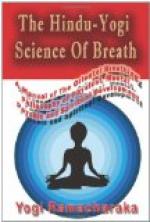Sit in an erect posture, keeping the spinal column straight, and the eyes well to the front, letting the hands rest on the upper part of the legs. Breathe rhythmically, but instead of breathing through both nostrils as in the ordinary exercises, press the left nostril close with the thumb, and inhale through the right nostril. Then remove the thumb, and close the right nostril with the finger, and then exhale through the left nostril. Then, without changing the fingers, inhale through the left nostril, and changing fingers, exhale through the right. Then inhale through right and exhale through left, and so on, alternating nostrils as above mentioned, closing the unused nostril with the thumb or forefinger. This is one of the oldest forms of Yogi breathing, and is quite important and valuable, and is well worthy of acquirement. But it is quite amusing to the Yogis to know that to the Western world this method is often held out as being the “whole secret” of Yogi Breathing. To the minds of many Western readers, “Yogi Breathing” suggests nothing more than a picture of a Hindu, sitting erect, and alternating nostrils in the act of breathing. “Only this and nothing more.” We trust that this little work will open the eyes of the Western world to the great possibilities of Yogi Breathing, and the numerous methods whereby it may be employed.
(11) The Grand yogi psychic breath.
The Yogis have a favorite form of psychic breathing which they practice occasionally, to which has been given a Sanscrit term of which the above is a general equivalent. We have given it last, as it requires practice on the part of the student in the line of rhythmic breathing and mental imagery, which he has now acquired by means of the preceding exercises. The general principles of the Grand Breath may be summed up in the old Hindu saying: “Blessed is the Yogi who can breathe through his bones.” This exercise will fill the entire system with prana, and the student will emerge from it with every bone, muscle, nerve, cell, tissue, organ and part energized and attuned by the prana and the rhythm of the breath. It is a general housecleaning of the system, and he who practices it carefully will feel as if he had been given a new body, freshly created, from the crown of his head to the tips of his toes. We will let the exercise speak for itself.
(1) Lie in a relaxed position, at perfect ease.
(2) Breathe rhythmically
until the rhythm is perfectly
established.
(3) Then, inhaling and exhaling, form the mental image of the breath being drawn up through the bones of the legs, and then forced out through them; then through the bones of the arms; then through the top of the skull; then through the stomach; then through the reproductive region; then as if it were traveling upward and downward along the spinal column; and then as if the breath were being inhaled and exhaled through every




